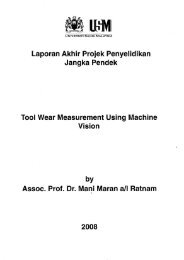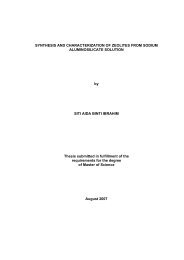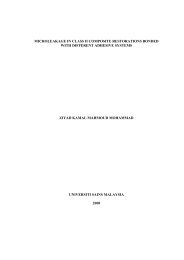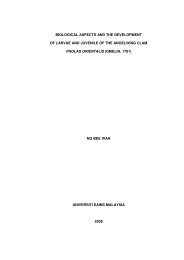a study on the performance of limestone roughing filter - ePrints@USM
a study on the performance of limestone roughing filter - ePrints@USM
a study on the performance of limestone roughing filter - ePrints@USM
You also want an ePaper? Increase the reach of your titles
YUMPU automatically turns print PDFs into web optimized ePapers that Google loves.
Figure 2.4: Sedimentati<strong>on</strong>s <strong>on</strong> Filter Media (Source: Wegelin, 1996)<br />
The <strong>roughing</strong> <strong>filter</strong> can be c<strong>on</strong>sidered as a sedimentati<strong>on</strong> basin, where <strong>the</strong> <strong>filter</strong><br />
media provides a large surface area and short settling distances for particle settling<br />
(Wegelin, 1996). In c<strong>on</strong>venti<strong>on</strong>al sedimentati<strong>on</strong> basins, particles have to reach a<br />
settling distance <strong>of</strong> 1 to 3 meters, whereas in <strong>roughing</strong> <strong>filter</strong>s, <strong>the</strong> settling distance to<br />
<strong>the</strong> gravel surface is <strong>on</strong>ly a few millimeters. Therefore, solid particles flowing through<br />
<strong>the</strong> <strong>filter</strong> touch and deposit <strong>on</strong> media surface within a few millimeters. Therefore<br />
<strong>roughing</strong> filtrati<strong>on</strong> is more effective process for particle removal than plain<br />
sedimentati<strong>on</strong>. Particles deposit <strong>on</strong>to media grains in dome-like formati<strong>on</strong>s (Wegelin,<br />
1986). The most particle accumulati<strong>on</strong> occurs in <strong>the</strong> bottom <strong>of</strong> <strong>the</strong> <strong>filter</strong> (Cleary, 2005).<br />
Sedimentati<strong>on</strong> <strong>of</strong> particles in <strong>the</strong> voids <strong>of</strong> <strong>filter</strong> media is part <strong>of</strong> <strong>the</strong> treatment<br />
processes for <strong>the</strong> removal <strong>of</strong> suspended particles in <strong>roughing</strong> <strong>filter</strong>. The process is<br />
known as settling or clarificati<strong>on</strong>. The efficiency <strong>of</strong> this process is measured by turbidity<br />
removal. It depends <strong>on</strong> size <strong>of</strong> particle and settling rate. Sedimentati<strong>on</strong> is a treatment<br />
process in which <strong>the</strong> velocity <strong>of</strong> <strong>the</strong> water is lowered below <strong>the</strong> suspensi<strong>on</strong> velocity and<br />
<strong>the</strong> suspended particles settle out <strong>of</strong> <strong>the</strong> water due to gravity. The settling velocity is<br />
influenced by mass density, size and shape <strong>of</strong> particle, as well as by viscosity and<br />
hydraulic c<strong>on</strong>diti<strong>on</strong>s <strong>of</strong> water. There is basic formula to calculate settlement velocity for<br />
a spherical particle by using Stoke’s law and it is given as:<br />
16

















